How and when to plant grapes in early spring
Planting of perennial and annual plants takes place at a certain time of the year, so that the rhizome takes root faster, and the green part of the plant begins to grow rapidly. Planting grapes with seedlings in spring is quick and without complications, if you prepare the soil, choose a planting site and provide the seedling with proper care.
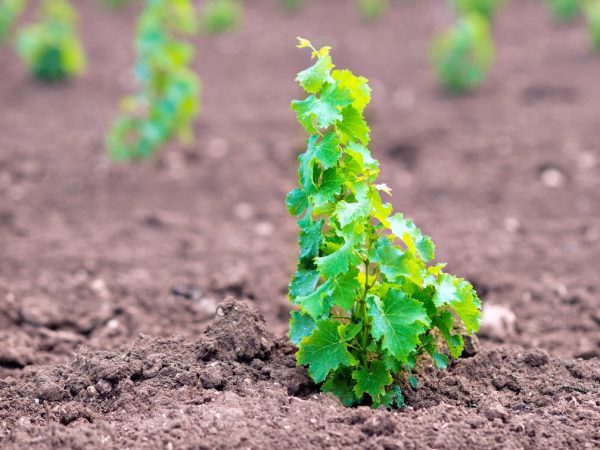
Planting grapes in early spring
Spring planting
There are prerequisites for planting grape seedlings in the spring: after frost, the land is depleted, but if you add fertilizer to it, it will become the most favorable environment for young plants. It contains a lot of moisture and nutrients. The optimal time for planting a horticultural culture is the end of March or the beginning of April. In these months, there are no frosts in the warm strip, but the intense heat has not yet begun - the shoot will have time to grow and get stronger before the arrival of new frosts. Spring grape seedlings are bought ready-made or taken out at home.
Cuttings are prepared from late summer and early autumn. They are defended in a cool place or soaked in a special solution.
In the spring, the purchased material is hardened for a couple of days, after which it is planted in open ground. Spring grape seedlings are able to germinate in a cellar or basement before spring: a developed root system of the shoot will allow the culture to take root faster.
Grapes are planted with cuttings and seedlings in spring, when the average outside temperature is above 10 ° C. This is a suitable temperature range for immature material. In addition, potassium permanganate solutions or commercial products are used to strengthen the plant, which do not allow pathogenic microorganisms to develop on the green part of the plant. In the spring, it is important to protect the culture from bacteria, fungi and diseases - the correct order of spring planting will save the future bush.
Benefits of spring planting
Spring planting is suitable for shoots that require time to grow: over the summer, the shoots will grow and get stronger. Spring planting is preferable in cases where you want to leave the grapes for the winter without additional shelter (you will not have to cover a plant with a strong root system). Spring disembarkation has the following advantages:
- the planted grapes bear fruit in a year;
- no additional shelters are required for the winter;
- the seedling does not require additional care: there is natural light and watering;
- vines grow rapidly;
- in the spring it is easier to calculate the planting time;
- for the rapid growth of the rhizome, it is easier to fertilize the soil.
The composition of the soil in the pit plays an important role in planting: in the spring it is easier to regulate the acidity of the soil, fertilize it or add nitrogen supplements (if necessary). In spring and summer, it is easier to prepare homemade fertilizers - vegetables, fruits, the remains of greenery or animal life are used for them.
In the fall, it is difficult to calculate the moment when the first frosts come, so in the spring the seedlings take root better. It is easier to arrange the future bush: in the spring, all winter and summer crops descend.
Disadvantages of spring planting
In the spring, seedlings are handled carefully: this type of planting has its drawbacks. After frost, the soil remains depleted, and without the introduction of additional fertilizers, it is difficult to guess with the correct soil for the root system of grapes. Sometimes a growing bush is threatened with a moisture deficit if there is little rain in the spring.
Problems will arise with seedlings if they are not covered with sawdust or humus - without additional protection, the bushes will quickly die. In spring, the shoots are threatened by fungal diseases: fungal spores multiply rapidly in favorable conditions (warm spring). Good grape varieties are more often sold in the fall, and if you do not cultivate seedlings yourself, but buy them, there is a risk of losing it over the planting time.
Planting grape seedlings
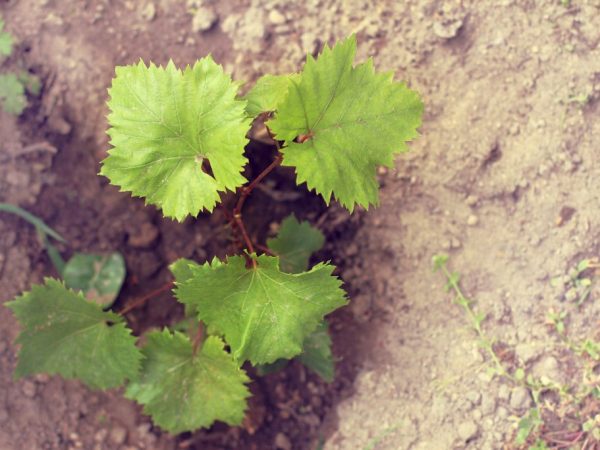
Plants need good lighting
For annual and perennial grapes, the soil, lighting, additional conditions are prepared: these requirements are the same for autumn and spring planting. During this period, watering, fertilizing the soil, introducing mineral complexes into the soil. Spring disembarkation is a multi-step process.
Preparing for planting in spring includes:
- selection of a suitable variety for the selected region (taking into account the climate, humidity, temperature difference in the region);
- soil preparation (the soil is abundantly watered, fertilized, dug up and loosened);
- choosing a suitable place where there should be no drafts or dampness.
It is important to take into account how the state of the soil and the ambient temperature will change: for annual and perennial grapes, a secluded place is selected, where it is easy to make additional shelter.
The planting of grapes is organized on the basis that in 2 months the soil will settle down and the correct moisture will be established. Watering should only be additional: the rhizome receives the main nutrients and moisture from the soil. Preparing for planting a crop will ensure its rapid and correct growth.
The choice of planting material
How to properly plant grapes in spring with a seedling: the quality of the future culture depends on the selected variety, therefore, planting grapes begins with the choice of planting material. The following criteria help to choose a variety:
- diseases that are tolerated by the bushes of the variety;
- average growth rate;
- resistance to diseases of other horticultural crops.
The most unpretentious planting material is annual. These are shoots with 3-4 roots. The total length of the planting material is up to 12 cm (it is ineffective to choose a long material). It is important to choose a stalk no thicker than 3-4 mm in diameter: it will quickly take root even without additional fertilization. A prerequisite for planting a shoot is soaking in a disinfectant solution. Such actions help to kill the pathogenic flora that multiplies on the selected material.
To plant a seedling, 2 days before that, it is placed in a special solution. To prepare it, you will need 10 parts of water, 400 g of clay and 200 g of hexachlorane. Dry shoots require additional moisture. Before planting them, the cutting is poured with water and left so for 2-3 days.
If the seedling has damaged roots, they are urgently removed. Before planting, the material is carefully checked: do not plant damaged sections, stems with spots or signs of decay. No more than 4-5 eyes are left on the shoot. 2-3 hours before the main event, the material is left in fertilizer: 1 part of manure and 2 parts of a growth-stimulating substance are thoroughly mixed. The mixture is diluted with water, and after soaking, it is added to the soil for feeding.
Seat selection
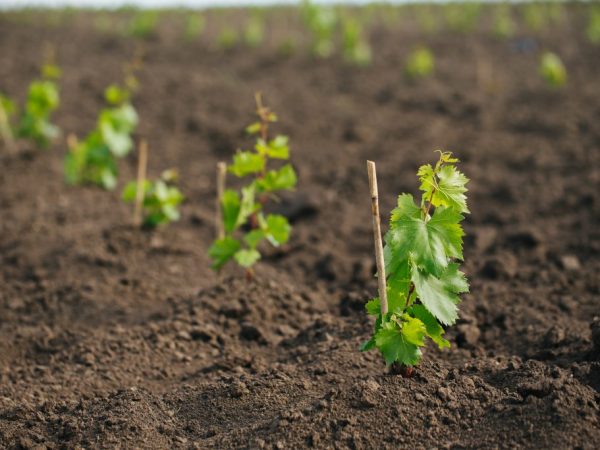
Plant grapes in an area without lowlands
How to plant young grapes in spring with seedlings: choose a suitable place where the culture will definitely grow for many years in a row.If a gardener plans to grow grapes, they choose a place where the vines can grow and will not interfere with other garden crops.
Where to plant grapes in spring with seedlings:
- in an area with good lighting;
- in an area with no lowlands;
- on a plot with fertile soil.
Shine
The main condition for a good harvest is the lighting of the site. Planting grapes in spring with seedlings involves choosing a site away from the shade: the less light, the less sugar in the berries. The grapes grown in the shade are sour and the clusters are small. Lighting should be uniform: the light falls on the entire surface of the bush, and not on one of its sides.
Moisture
Grape seedlings grow poorly in spring if excess moisture is constantly collected on the soil. In the lowlands, water is constantly collected (if it rains often, such stagnant water is a source of diseases from other horticultural crops). Due to an excess of moisture, the root system of the bush rots, and the vines wither quickly. Before planting grapes, the relief of the selected area is calculated.
The soil
The decisive condition for planting grapes is the composition of the soil: choose areas for planting with fertile soil. If the soil is not of the best quality, and the gardener does not have another site, a special planting pit is prepared: it is fertilized and moistened soil, which is constantly fed with mineral additives. A fertile layer for grapes requires humus and mineral salts. For the rapid growth of shoots, a good soil moisture capacity is needed.
Choosing a suitable period
When is it better to plant grape seedlings: in spring, after warming, when the upper layers of the soil have warmed up. The exact planting time is determined by the crop variety and the region in which the land plot is located. Trees are planted only at a minimum ambient temperature of 15 ° C. The average soil temperature should be at least 10 ° C. If the spring turned out to be cold, you should not rush to plant the material. Weak roots can die due to frozen soil layers.
A suitable time for planting vegetative materials is from March to June. Many are not afraid to carry out work on planting horticultural crops at the beginning of summer: if you fertilize and moisten the soil with high quality, the shoot will get stronger until autumn and will be able to survive the winter.
2 types of shoots are planted in open ground: vegetative and woody.
Vegetative
The first type of seedlings is planted in the spring, they are young. Such material is sold with a soil mixture, it is suitable for urgent planting in open ground. There is at least one leaf on vegetative materials, which indicates the ability of the shoot to grow. It is planted from May 20 to June 20.
Stiffened
The second type of planting material germinated in the ground, but for the winter it was transplanted into a container and left in a warm room. Such a seedling has a well-developed root system, there are buds on the stem. This material is best planted in early spring.
Landing pit
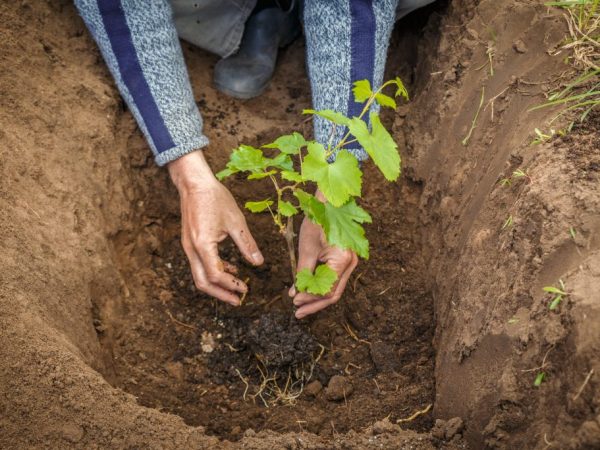
The landing pit is prepared in advance
In the middle lane, the cutting is quickly adopted. In unfavorable conditions, if there is no good soil on the site, they dig a planting hole. The dug hole is well fertilized and watered a few days before planting the cutting.
Optimal sizes of planting holes:
- 80 cm long;
- 70-80 cm wide;
- 60-70 cm deep.
For the middle lane, there is no need to dig holes that are too deep. In this case, surface water feeds the shallow plant.
At home, half a meter or a meter of free space is left around the hole. This is a place for the growth of the root system, the introduction of basic and additional fertilizers. The average service life of the pit is at least 4 years.
How to make a landing pit
The first step is to dig a hole: if there is such a need, they measure the exact depth and area of the hole. The soil layers are divided into 2 identical heaps (upper and lower). The first layer is fertile soil.The bottom of the dug hole is covered with it, so that the root system of the plant begins to grow rapidly. The bottom layer must be at least 10 cm thick. Fresh humus is poured into a dug hole with lined soil (the natural additive is diluted with nitrogen fertilizer and wood ash).
Manure fertilizer is well rammed, and a layer of fertile soil is covered on top (at least 10 cm in height). The top layer and manure are well mixed. The composition of the planting pit is needed not so much for young shoots as for grapes during its fruiting period. As the rhizome grows, it reaches a layer of fertile soil, and the plant feeds on the most useful components, thanks to which it will be possible to harvest a high-quality crop.
The number of layers of manure and soil depends on the depth of the hole. Leave only 20 cm of free space to the general soil level on the land plot. Shoots are planted on a day when all layers of the pit are lined.
The second type of landing pit
It is not necessary to plant the planting material in fertilizer with manure. An alternative fertilizer that is mixed with fertile soil:
- 200-300 g superphosphate;
- 200 g of potash fertilizer;
- water.
You cannot plant a tree if the fertilizer for the pit is lumpy: the homogeneous structure of the soil mixture will allow the root system to grow faster. For the planting hole, soil is brought from another site: such a layer allows you to strengthen the process.
As soon as the hole is formed (soil layer, fertilizer layer), it is watered with water at room temperature. The top of the hole is always lined with soil. Moistening of all layers is carried out before planting the planting material. For dry land, one hole takes up to 2 buckets of water.
How to plant an escape
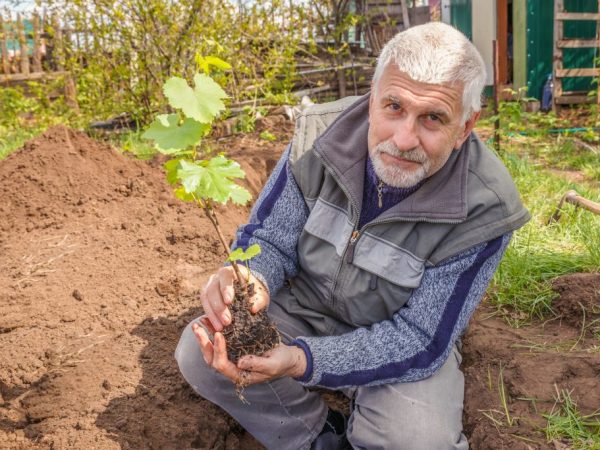
Plant in dry weather
A planting hole is made in autumn or early spring (the top soil will be able to retain all the nutrients of homemade or purchased fertilizer). If the site is in the suburbs or another region with a warm continental climate, planting is carried out immediately after the preparation of the pit.
How to plant prepared material:
- In the center of the hole, a deepening of 30-40 cm is made. Before this procedure, the subsidence of the soil is checked.
- If the hole subsides, the depression is not made more than 35 cm (these are holes that were dug on the eve of planting). Over time, the root system of the seedling automatically descends to the desired depth.
- A stalk is carefully transplanted into the middle of the recess.
Planting of the material takes place in dry weather. If a support is provided for the vines, the shoot buds are deployed to it. The rhizome of the future bush is covered with the remains of the soil and watered abundantly. During planting, it takes from 40 to 50 liters of clean water.
In the spring, the planted material is covered: this way it absorbs moisture faster and gets used to the ambient temperature. Once the plant has acclimated, the shelter is removed. The fortified culture is fertilized and mulched. To insulate the rhizomes, the upper layers of the soil are covered with sand or additional fertile soil.
How to protect a fresh crop
To get used to it completely, the escape requires a period of 2-3 weeks. If the material is planted on time, the soil subsides, and the culture begins to grow actively. From the beginning of spring to summer, young shoots do not need shelter. They only slow down the vegetation of the plant. During cold snaps, the shoot is covered with a cardboard box or tarpaulin: such a shelter cannot be permanent. During the day, a growing culture needs natural light.
Watering the plant will not create difficulties if additional devices are made: plastic bottles without a bottom are buried between the shoots. They are flooded with water that enters the soil over a period of time. From the third year, additional watering of the varieties is not needed. Such crops independently draw moisture from the soil. It is important to choose the correct depth and composition of the planting holes: the deeper the roots of the future bush are, the better the harvest will be.
Conclusion
With the beginning of spring, shoots of table varieties are planted. For this, one-year-old shoots or varieties are chosen that quickly adapt to new conditions. To plant the planting material, prepare the soil and soak the planting material.
The planting hole is covered with layers of fertile soil and fertilizer. The material is planted in it from the beginning of May to June. After 2 weeks of active growth, constant watering and periodic fertilization are established for the shoot. A simple planting and care scheme allows you to harvest a good and tasty harvest next year.


